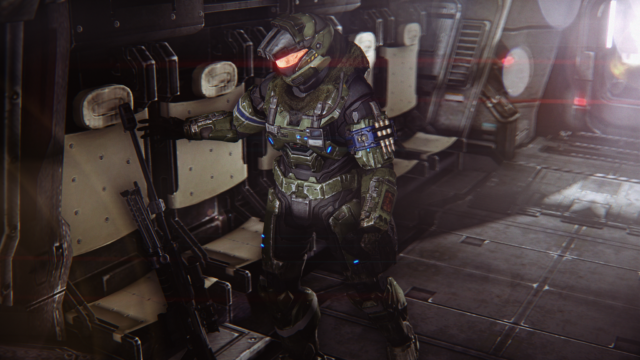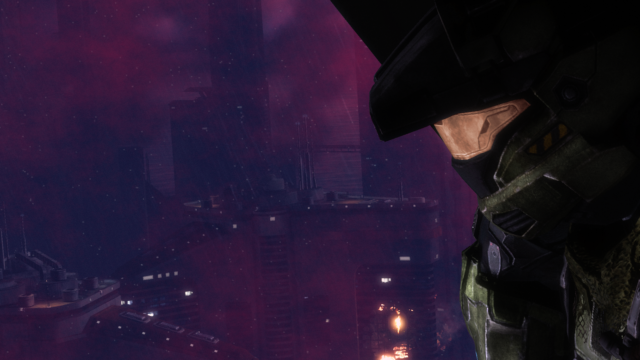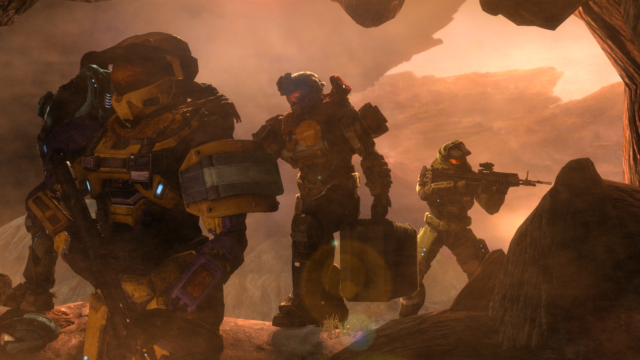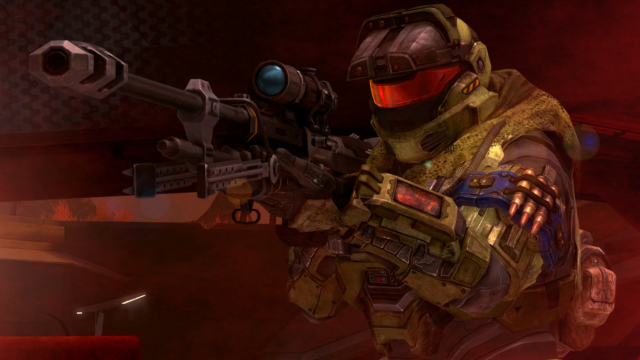
Perhaps the most potent corollary of Noble Team’s journey in Halo: Reach is the insidious feeling of absence which germinates during the course of the invasion, the nauseating compilation of genocide which mission after mission grew in intensity. The vacuous vessels which become our Spartan-III companions take on a deeper personality through the careful use of slaughter in the overall campaign, laughably emotionless on their own, but in synchronicity with the unsettling tone, off-putting and meaningful to the player. It can not be overstated that Bungie knew when to utilize the gritty bane of war to create an effective emotional connection in the place of character development, and the swift obliteration of Noble Team is what made their lone sniper’s mysterious disappearance so much more impactful.
Three long years after we stepped out of B312’s bloodied boots and turned our heads from the ashes of the glassed planet, Halo: Initiation granted fans a reunion with the vigilant eye of Noble, clad in a black suit rather than grimy Mjolnir. Jun-A266 had done what was necessary, securing a victory in the deliverance of Doctor Catherine Halsey off of Reach. He had walked away from perhaps the barbarous massacre of the Human-Covenant War, living to see the climax of the war, and the end of a twenty-eight year long conflict rising from the fervent zeal of false prophets.
The Spartan survived to see the day some thought would never come, the armistice fought and bled for by his closest comrades, allies left behind in the simmering glass fields of Reach.

“Look at this place. Used to be the crown jewel… Not anymore.”
Spartans as a collective were no strangers to tragedy, remarkably short life expectancies overshadowing the development of individualistic traits that impaired or hindered combat ability. Halo: Reach, and subsequently whatever scraps of Halo media have covered the tribulations of Noble Team, have exposited to us that the special warfare unit shared a robust bond during their brief time together. The crusade to rescue the planet from certain destruction is framed in an air of rapidly escaping hope, much like air discharging from a hull breach. Though these successively more harrowing scenarios illustrate the idea that the narrative’s objective is to be viewed through the eyes of player character Noble Six, it is felicitous to state that the sniper’s scope is now the most effective lens to peak through.
As the game progressed, each member of Noble Team died remarkably less optimistic that their sacrifice was for a greater good, and even perhaps for the safety of Reach. As the raging sun set on the ashen plains of a once lush planet, the only victory that had been directly secured by Jun’s team-mates was the invaluable time to strategize, to combat the goliath threat which loomed on the horizon, undone by its own schism.
The demise of not only Jun’s closest allies but his fellow humans on Reach plausibly inflamed already prevalent psychological issues, P.T.S.D. clandestinely lurking under the Scout-class Mjolnir, never quite rearing its terrifying head. Clasped in Jun’s hand was a fistful of arrows, but he no longer had the bow to launch them from.

“We are just like this rifle, Six. When we have done our jobs, we are discarded just as easily.”
Noble Three’s reintroduction into post-war society is in the wake of uneasy social and political footing, the place of dated Spartan candidates a topic of heated disputations both in-universe and surrounding the modern iterations. Jun’s proactive role in the Spartan-IV program is one to be examined and investigated, tying heavily into his encounters on Reach. Jun imprisoned much of his sentimental tenants after the genocidal campaign, restraining himself emotionally and getting progressively less humane as the battles toiled on. Even though he was outwardly viewed as dramatically more individualistic than most of his augmented siblings, the striking austere and callous rejection of the murders of Noble Team was disconcerting on a psychological level.
Having a vigilant eye for skill, Jun’s role as an adviser and leader for the newest generation of warriors also heavily ties into the above emotional absences. The Spartan-III’s best outward projection of his misery and regret is through reconstruction, desperately vying to rebuild the Spartan program. His requisition of a Mjolnir variant mimicking his own might seem outwardly conceited at its worst, but it becomes heartbreaking when Jun’s influence in the development of sets modeled after Jorge, Kat, and Emile is implied in their creation.
Despite ostensible evidence that Jun was not phased by the death of his team, minor actions such as these undoubtedly prove that Jun is internally grieving, and passionately working to resurrect the valiance of Noble in the only conceivable way he can. Though the band of warriors was burned to cinder on the fields of Reach, Jun could pass the torch of their heroism to the Spartan-IVs.

“During my last psych eval they asked me what I felt while reducing civilian unrest. I told them, slight recoil.”
While Jun’s follow-up appearances are welcome additions to the somewhat absent characterization Noble Team received in their only story, a fair few have voiced discontent toward the decision to unveil the Spartan-III’s fate. It is admittedly necessary to concede that the uncertainty surrounding Jun’s disappearance is cogent, but the void it leaves is far too pernicious when wholly vacant. Even putting this aside, the intrigue surrounding his escape from the smoldering remains of Reach is still somewhat intact, as the exact details of his departure are still intentionally vague in the lore. The objective of Jun’s character is far more credibly realized with the sniper as a vital part of the universe, leaving a voice to speak amidst the hushed silence that followed the Reach campaign. Jun can, by extension, more effectively develop the various vacuous traits of each member of Noble without aimlessly resurrecting them and undoing the impact of their collective demise.
It is entirely possible that Jun’s reluctance to recruit the rest of Alpha-Nine to the Spartan-IV program may have connected to his own trepidations, uneasy with the loss of Noble Team and striving to spare Edward Buck the same trauma. In his appearances following the events of Halo: Reach, Jun has been shown as dedicated, but never slipshod, efficient to a fault. Never a carefree man, nor one lacking in a visible code of conduct he wears on his sleeve, Jun’s strenuous slavery to the Spartan program remains an indomitable barrier in the path of recovery.
Jun-A266 is the easily most salient opportunity Halo: Reach has provided, a man that can single-handedly supply a satisfactory conclusion to a collection of arcs introduced seven years ago. The weight of Noble Team, their fighting spirit, genius, command, and wrath, all lie atop the shoulders of the lone survivor, a burden he cannot carry alone.
(Header image created in tandem by HaruspexofHell and Joshua Ezzell.)



 iTunes
iTunes Zune
Zune RSS
RSS Facebook
Facebook Twitter
Twitter Twitch
Twitch
One Response to Running From New Alexandria – The Significance of Jun’s Return to Halo